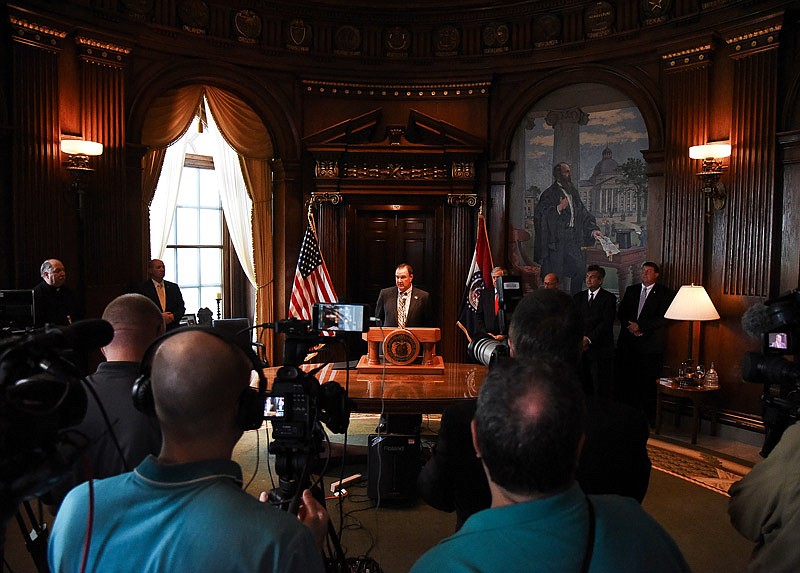Gov. Mike Parson had the authority to name Mike Kehoe as Missouri's new lieutenant governor, Cole County Circuit Judge Jon Beetem ruled Wednesday afternoon.
And the Missouri Democratic Party and World War II veteran Darrell Cope, "as private parties, lack authority to seek the removal of a state official from office by litigation," Beetem said.
Matt Vianello, the St. Louis attorney who filed the lawsuit challenging Kehoe's appointment as lieutenant governor, only hours after it was made on June 18, told the News Tribune on Wednesday: "My clients are disappointed in the result, and we are exploring our options for appeal."
Attorney General Josh Hawley's office argued against the lawsuit and urged Beetem to dismiss it - as Wednesday's ruling did.
Mary Compton, Hawley's spokeswoman, said: "We are pleased that the court has upheld Gov. Parson's authority to make this important appointment.
"We look forward to Lt. Gov. Kehoe's distinguished service in his new office."
Filling the vacancy became an issue when former Gov. Eric Greitens resigned June 1, and Parson - who had been elected as lieutenant governor in November 2016 - was sworn in to succeed Greitens in the chief executive's job.
In a statement, Parson applauded "the Court's expedient decision to dismiss the plaintiffs' case.
"This affirms our position as well as the position of previous governors from both parties."
He told reporters before a dinner at the Mansion: "We think it was very important to us to get that lieutenant governor's seat in place, and to move forward."
In a separate statement, Kehoe said: "I have consistently indicated I believe the governor has the authority to appoint a lieutenant governor, but I have also repeatedly said that I will abide by the court's decision on this matter. I am grateful for, and agree with, Judge Beetem's ruling and look forward to continuing to work on behalf of all Missourians."
In his nine-page ruling, Beetem cited the Missouri Constitution's Article IV, Section 4, which states: "The governor shall fill all vacancies in public offices unless otherwise provided by law, and his appointees shall serve until their successors are duly elected or appointed and qualified."
Adopting the attorney general's use of dictionary definitions to explain, in detail, the meaning of the Constitution's words, Beetem wrote: "It is undisputed that Missouri law does not 'furnish' or 'supply' a method of filling the vacancy in the office of Lieutenant Governor 'in (a) different manner' or 'in another way.'"
The judge pointed to the original lawsuit's pleading that "Missouri law provides no way to fill a vacancy in the office of Lieutenant Governor."
Vianello had argued in a hearing June 5, as well as in the original lawsuit, that the lack of a specific statute meant the governor had no power to fill a vacant lieutenant governor's job.
Beetem said, "The plain language of Article IV, Section 4 authorizes the Governor to fill the vacancy unless Missouri law furnishes or supplies another way to fill it."
And, he said, the plaintiffs' admission that no specific law gave directions on how to fill a vacancy in the lieutenant governor's office was "fatal" to their case.
Solicitor General D. John Sauer had argued last week that Cope and the Democratic Party couldn't ask the court to remove Kehoe once he had been appointed, because state law requires an ouster action - called a quo warranto case - to be filed by the attorney general or by a county prosecuting attorney.
Additionally, Sauer told Beetem last week, the Constitution requires the House to approve articles of impeachment for any of the six statewide elected officials, including the lieutenant governor.
Vianello had countered that those arguments couldn't apply if the governor didn't have the power to make the appointment.
Beetem agreed with the argument that Kehoe, as Missouri's "de facto" lieutenant governor, could not be removed from office by private citizens.
However, in a footnote, he disagreed with the state's argument that impeachment now would be the only way Kehoe could be removed from office before the 2020 general elections.
"He was not duly elected and is better described as a statewide appointed executive official," Beetem explained in the footnote. "Unlike an elected official, (where) there is no other no way to challenge the propriety of his appointment, (Kehoe) would be impeachable, but that is not the exclusive manner of removal for certain claims."
Parson thanked Hawley's office for its work on the case, and said: "We look forward to continuing our work with Lt. Gov. Kehoe."
In his statement, Kehoe said: "When I was sworn-in as lieutenant governor on June 18th, I pledged to Gov. Parson and the people of Missouri that I would work to improve the state through infrastructure and work-force development.
"Since then, I have visited state departments throughout central Missouri, met with community and business leaders across the state, and begun the process of integrating myself with the numerous boards and commissions on which I will serve."

